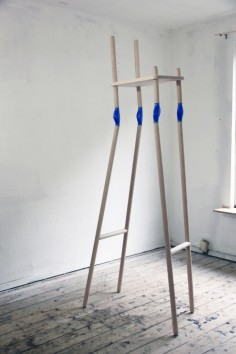Lina Marie Koeppen
source: art-vibes
La giovane designer Lina-Marie Köppen ha realizzato e progettato una serie di oggetti non convenzionali e dalle funzioni misteriose.
L’obiettivo della sua tesi di laurea alla Design Academy di Eindhoven è stato quello di studiare in che modo sia possibile mettere in discussione il rapporto di percezione del soggetto con l’oggetto, essendo questa funzione mediata da abitudinarie convenzioni.
Il suo progetto risulta essere veramente molto interessante, ci induce ad avere a che fare con oggetti quotidiani imperfetti, all’apparenza senza senso, che , con un po’ di fatica iniziale, vanno categorizzati e compresi.
Il motto della giovane designer berlinese è “learning to unlearn” (imparare disimparando), infatti il suo studio diventa per noi un esercizio di riattivazione della memoria, di reinvenzione di significati in rapporto agli oggetti, che mette in moto il nostro inconscio e la nostra memoria.
Vi lasciamo ai vostri esercizi di interpretazione attraverso le immagini..
.
.
.
.
.
.
.
source: sitedouban
如果我们对日常物品一无所知,我们会希望它们是个什么样子呢?在这种概念模糊的情况下,产品的不确定性和对产品的重新定义,就引出了“学会忘却”这一种设计思想。
一张两条腿的凳子,一盏举着才能打开的灯,一把有两个把手的扫帚,一个很长毛的刷子。这些对象中,我们可以辨认出局部,却不知道它们的功能。通过推翻它们预定的功能,我们可以重新定义它们,按照自己的想法,充分的利用它们,探索新的可能。
.
.
.
.
.
.
.
source: designboom
as part of her thesis for the design academy eindhoven in the netherlands, lina-marie köppen developed the ‘learn to unlearn’ project.
the work explores the concept of creating objects in reaction to our daily routine – designing ‘failure’ in order to foster new governing behaviors in
antithesis to those that are automatic, entrenched as promoted by society. the family of 8 objects reference and provoke familiar items we interact with daily –
a two-legged stool that challenges the concept of sitting, a broom with two handles – each one appealing to user self-awareness and encouraging rediscovery.
köppen interrogates what society defines as ‘normal’, inserting simple interventions into ordinary artifacts to highlight the ways in which
we create identity and therefore interface with our surroundings based on societal reproduction.
köppen discusses the philosophy behind her work:
‘my design reaction proposes a new model – ‘learn to unlearn’ is the belief in self-empirism and ‘limitation’ as an endorsement of personal identity. ‘learn to unlearn’ is not a design method but rather a common ideal of seeing, feeling, deciding, and interacting directly with our environment. in that sense, unlearning is only possible if we are forced to adapt to alleged failures. designing failure is nothing more than a stepping stone on the way to a new human experience.
the design approach is a reaction to our daily routine: these objects thicken time, challenge statics, and upend our notions of utility and relations, allowing us to get closer to ourselves and re-experience our relationship to our environment. all eight objects are a family, in that sense, sharing the same idea about man and society. they were formed out of two questions: is it possible to design objects that enhance self-empathy and therefore self-awareness through unlearning? furthermore, is it possible to escape societal production and therefore the formation of a self-contradictory identity?
according to society´s normal standards, this family of objects functions imperfectly – that is, they function according to their own conditions, which may create outcomes different to the expected results. this disturbance is needed to sensitize the user to the interactions suggested by the objects and therefore endorse a more conscious relationship. each product tells its own story, and if you listen carefully, they communicate how they became what they are today.western society has generated its own biggest conflict. we feel the need to compete with things that were built in the first place to improve mankind.designing ‘failure’ could become the most important message in design.’
.
.
.
.
.
.
.
source: ambientesdigital
Muchos de los usos y significados de los objetos que nos rodean son heredados. No hubo una reflexión personal sobre ello, simplemente aceptamos que un cepillo es para determinados fines y una silla es para otros. Nuestra relación con este saber es mecánica e impersonal. Lina Marie Koeppen, con su línea Learn to Unlearn, se propuso hacernos reflexionar sobre las expectativas societales, tanto de los objetos como de nosotros mismos; reflexionar también sobre la creación de una identidad auto-contradictoria, determinada por el contexto y nacida de un auto-conocimiento que viene precisamente del desaprender los actos y el conocimiento reflejo o mecánico. Los ocho objetos que componen la colección cumplen diversas funciones; una lámpara puede ser un cepillo, y éste puede ser luego una silla, o un andador. No hay definición, y por tanto no hay restricción; el mismo diseño se está creando y repensando constantemente, generando una interacción directa y personal con éste y el entorno.


